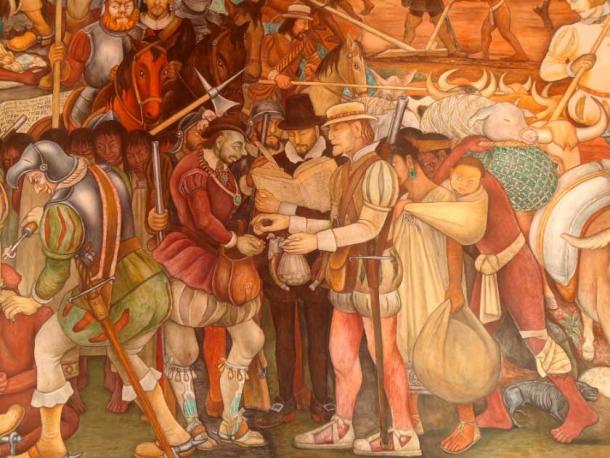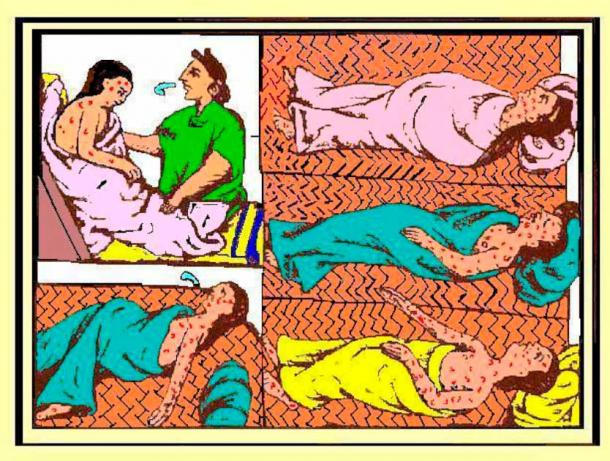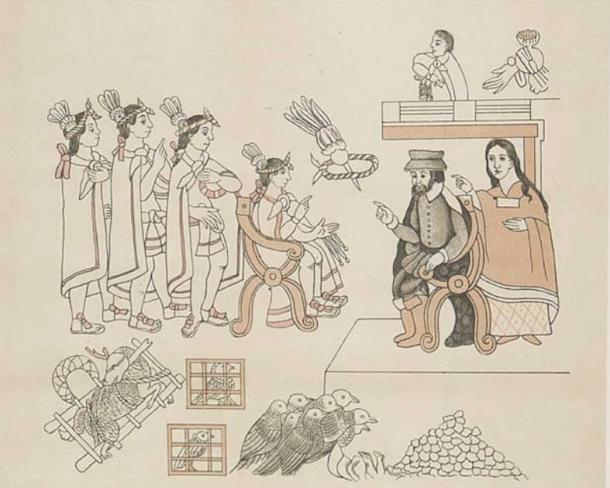
What was the Deadly Cocoliztli Disease that Decimated Aztec Society?
When the Spanish crossed the Atlantic and started arriving in hordes to begin their conquest and plunder of the Americas, they had a weapon in their arsenal that they had not anticipated: disease. Isolated indigenous tribes, who had no immunity to ‘Old World’ diseases like smallpox, measles, or influenza, among others, started dropping like flies overnight. Between 1545 and 1550, Aztecs from southern Mexico experienced a deadly outbreak of a mysterious illness, that took anywhere between 5 million and 15 million lives, nearly 80% of the population!
It was colloquially called cocoliztli, meaning ‘pestilence’, but little was known about the reign of terror that this disease caused in this part of the world, until a few years ago. A groundbreaking study from 2017 published in Nature Ecology and Evolution was able to trace the outbreak to salmonella, a bacterial infection that causes a type of enteric fever nearly identical to typhoid.
The demographic catastrophe unleashed by cocoliztli was unlike any other the world had ever seen. The numbers speak for themselves. When the Spanish arrived in Mexico in 1519, Mexico’s population was anywhere between 15 and 30 million, but by the year 1600, it had been wiped out to just two million people.
- Aztec Palace Complex and Later Cortes Home Unearthed in Mexico City
- 16 Absolutely Terrifying Aztec Artifacts

Arrival of Hernan Cortez by Diego Rivera in the Palacio Nacional (KGV88 / CC BY SA 3.0)
What Caused Cocoliztli?
While war was a hugely contributing factor, along with other diseases, 21st century studies have pointed to a spate of hemorrhagic fevers of ‘unknown origin’ as responsible for at least 60-70% of these deaths. The disease appeared sometime in 1545, constituting the first wave of this major epidemic, with other major waves occurring in 1576, 1736 and 1813. Lesser outbreaks were registered in 1559, 1566, 1587, 1592, 1601, 1604, 1606, 1613, 1624, and 1642. In Tlaxcala alone, up to one thousand people died daily.
For the ethno-historian Charles Gibson, there is no “sure method for determining whether the later [colonial era] counts were more accurate or less accurate than the earlier ones,” so that “the magnitude of the unrecorded population seems unrecoverable.” These epidemics were so dangerous precisely because the ‘New World’ populations had no previous contact with the diseases that struck them, making them immunologically defenseless.

Disease played as large a part as war in the fall of the Aztec Empire. The Last Days of Tenochtitlan, final battle of the Spanish conquest of the Aztec Empire in 1521. Painting by William de Leftwich Dodge, 1899 (Public Domain)
Tracing salmonella was a Herculean task for many reasons. Spanish and indigenous artists show the infected with nose bleeds, coughing up blood, but there are no visible indentations or remnants on the skeleton. The same study mentioned earlier was able to trace 500-year-old DNA embedded in the teeth of 24 individual’s dental remains. These were run through a DNA sequencing analysis called MALT, a computational program that stores information from all known pathogens.
At least 10 of the 24 samples came back positive for salmonella, and to corroborate this, five individuals buried before the coming of the Europeans were tested. None of these five had DNA evidence of salmonella.
- The Fall of Tenochtitlan - Truly the End of the Aztec Empire?
- Aztec House and Floating Gardens Discovered Under Mexico City

The Aztec population was helpless against unknown ‘Old World’ diseases. Panel from the Florentine Codex depicting smallpox outbreaks in the Americas during the 16th century. (Jaontiveros / CC BY SA 4.0)
Aztec Reaction to Cocoliztli Catastrophe
The descendants of the Aztecs, the Nahua, ascribed a spiritual reason to this. In their writings, which heavily recorded the pestilence, there was a firm belief that these waves of disease were bad omens. These omens were brought on by the proselytization that the friars who crossed the Atlantic, and the looming threat of Christianity and its various traditions remained alien and removed from the socio-cultural reality of the native populations.
“In 1576, another great pestilence struck this land, bringing death and destruction to the native population. It lasted over a year and brought ruin and decay to most of New Spain [the Spanish Viceroyalty covering today’s Mexico], as the native population was then almost extinct. One month before the outbreak of the disease, an obvious sign had been seen in the sky: three circles in the sun, resembling bleeding or exploding suns, in which the colors merged. The colors of those three circles were those of the rainbow and could be seen from eight o’clock until almost one o’clock at noon,” wrote Diego Muñoz Camargo, a famous historian from the era.
Friars, on one hand, attributed the epidemics to God’s divine mercifulness. They believed the natives were being freed from the sufferings of colonial control. Others, like Jesuit José de Anchieta, believed it to be God’s punishment against the idolatrous natives. He further advised all those who had not been Christianized, to follow the path of Christ and be freed from the suffering of this invisible killer.
Yet others saw divine mandate and opportunity. The friar Gerónimo de Mendieta thought the plagues a message from God. “God is telling us: ‘You are hastening to exterminate this race. I shall help you to wipe them out more quickly’”, he quipped. John Winthrop, governor of Massachusetts, wrote that “for the Natives, they are nearly all dead of smallpox, so has the Lord cleared our title to what we possess”, alluding to the battle over land and resources that still features prominently in the politics of the Americas.

Cortez and La Malinche meet Moctezuma II. , November 8, 1519, circa 1550 (Public Domain)
Colonialism and the Slave Trade: A Deadly Combination
A number of factors were at play, resulting from the perils of colonialism and the transatlantic slave trade, which resulted in the inflow of slave labor from the western African coast to the Americas, by the Europeans. The Europeans realized the opportunities presented by new cash crops, but needed a surplus of readily available labor to work the fields.
Slaves were transported and housed in heinous conditions, with an average lifespan of 23 years. A number of scholars have commented on the correlation between slave labor and disease. Housing so many human beings in such small quarters led to the rampant spread of disease. We now know that paratyphoid fever spreads through food or water contaminated with the feces of a sick person. Today, it usually breaks out when people live in poor, crowded conditions.
Faced with large-scale environmental degradation and economic collapse, local communities were affected by poverty, malnourishment, and the harsh working conditions. All of these factors exacerbated cocoliztli’s destructive power.
The cocoliztli outbreaks also caused disruptions in food supplies, famines, changes in population concentration, and relocation – all potentially contributing factors to the contagion of salmonella. There was another possible factor – the salmonella could have likely travelled across the Atlantic with the domesticated animals brought by the Spanish. By the time Hernán Cortés and his troops began their final assault on Tenochtitlán, the small Spanish force was easily able to overcome the shocked native populace.
Top image: Mictlantecuhtli, the Aztec god of the dead, was quite busy in 15th century. The cocoliztli epidemic may have killed up to 15 million people! Source: Ivan / Adobe Stock
By Sahir Pandey
References
Acuna-Soto, R. et al. 2002. Megadrought and Megadeath in 16th Century Mexico. Emerging Infectious Diseases, 8(4). Available at: 10.3201/eid0804.010175.
Acuna-Soto, R., et al. 2004. When half of the population died: the epidemic of hemorrhagic fevers of 1576 in Mexico. FEMS Microbiology Letters, 240(1). Available at: https://doi.org/10.1016/j.femsle.2004.09.011.
500 years later, scientists discover what probably killed the Aztecs. January 15, 2018. AFP. Available at: https://www.theguardian.com/world/2018/jan/16/mexico-500-years-later-scientists-discover-what-killed-the-aztecs.
Chen, A. January 16, 2018. One of history's worst epidemics may have been caused by a common microbe. Science.org. Available at: https://www.science.org/content/article/one-history-s-worst-epidemics-may-have-been-caused-common-microbe.
Herzog, R. September 23, 2020. How Aztecs Reacted to Colonial Epidemics. Available at: https://daily.jstor.org/how-aztecs-reacted-to-colonial-epidemics/.
Vagene, A.J. et al. 2017. Salmonella enterica genomes from victims of a major sixteenth-century epidemic in Mexico. Nature, Ecology and Evolution. Available at: https://doi.org/10.1038/s41559-017-0446-6.
Zhang, S. January 15, 2018. A New Clue to the Mystery Disease That Once Killed Most of Mexico. Available at: https://www.theatlantic.com/science/archive/2018/01/salmonella-cocoliztli-mexico/550310/.
















Comments
30 people.. even today that wouldnt be considered a significant sampling... And ive had severe salmonella myself . Htf do u accept the thought that a gut infection that causes severe cramps n diarrhea can give hemorrhagic fever?? Yeah so lessn half after had it n none of the 5??!! (Really??!! ur conclusions are based on only 5 data points?) This is another reason y noone "trusts the science" anymore
infinitesimal waveparticles comprise what we call home the earth
manipulatable by thought ability supressed in humans since birth
‘Poisoning the well’ goes all the way back to the so-called ‘dawn of civilization’. And the aboriginals before that would have been well-learned of the toxic/deadly bacterial substances that COULD be produced in the fermentation of grains, such as rye, and fruit pits. These substances include both cyanide and arsenic, which are KNOWN BLOOD AGENTS. So you’d have to guess the Spaniards added one of those substances to the water supply.
Nobody gets paid to tell the truth.